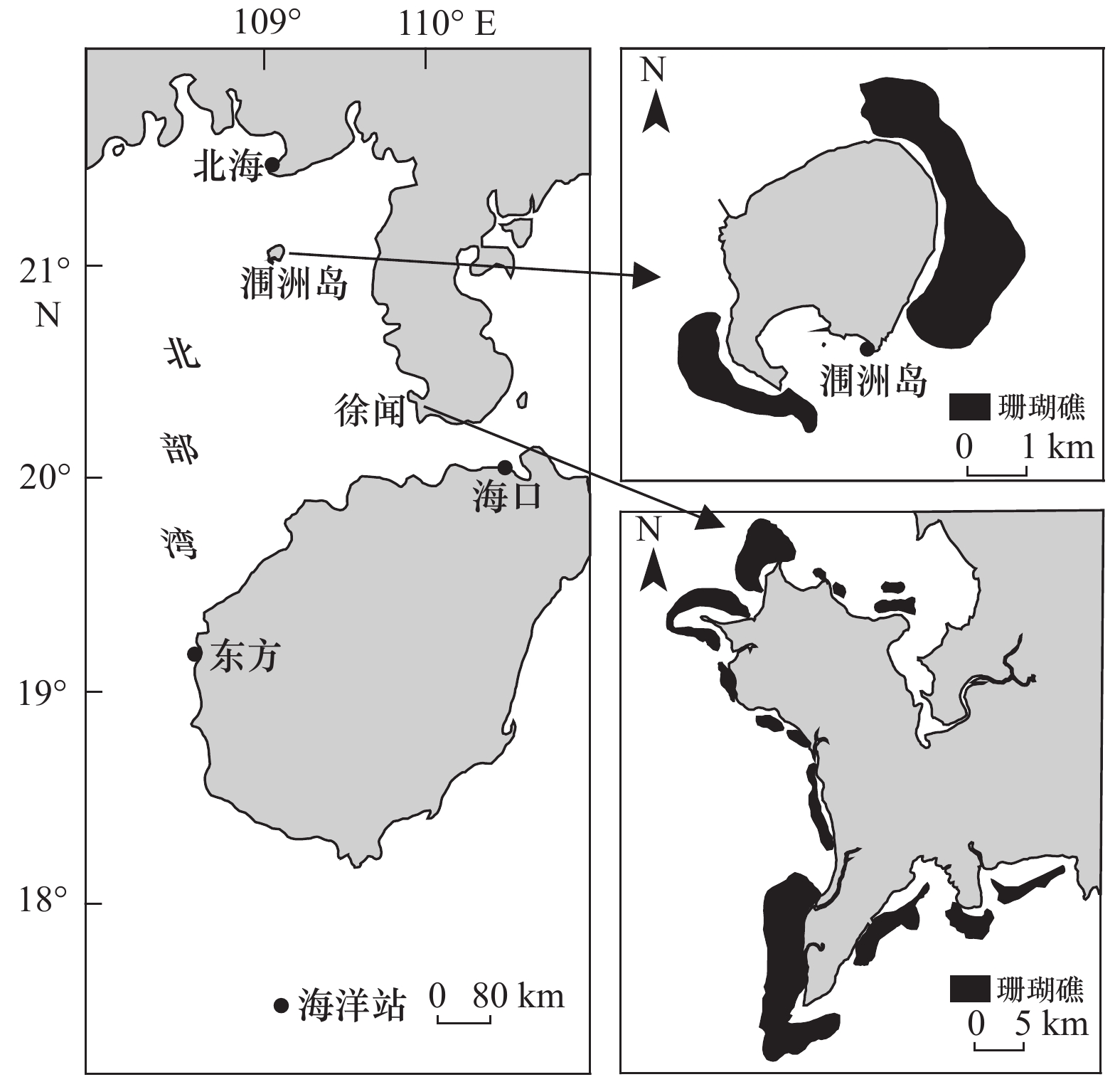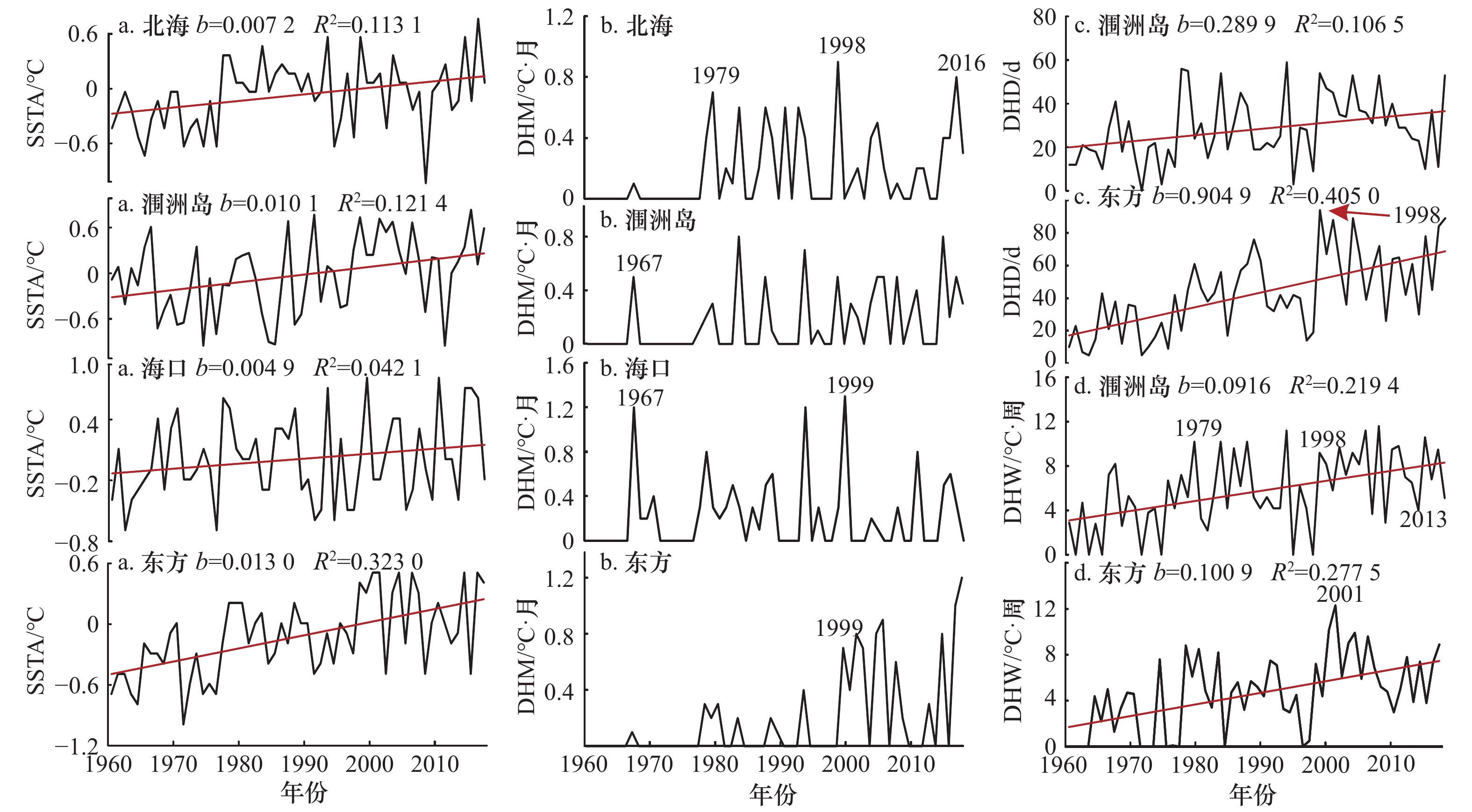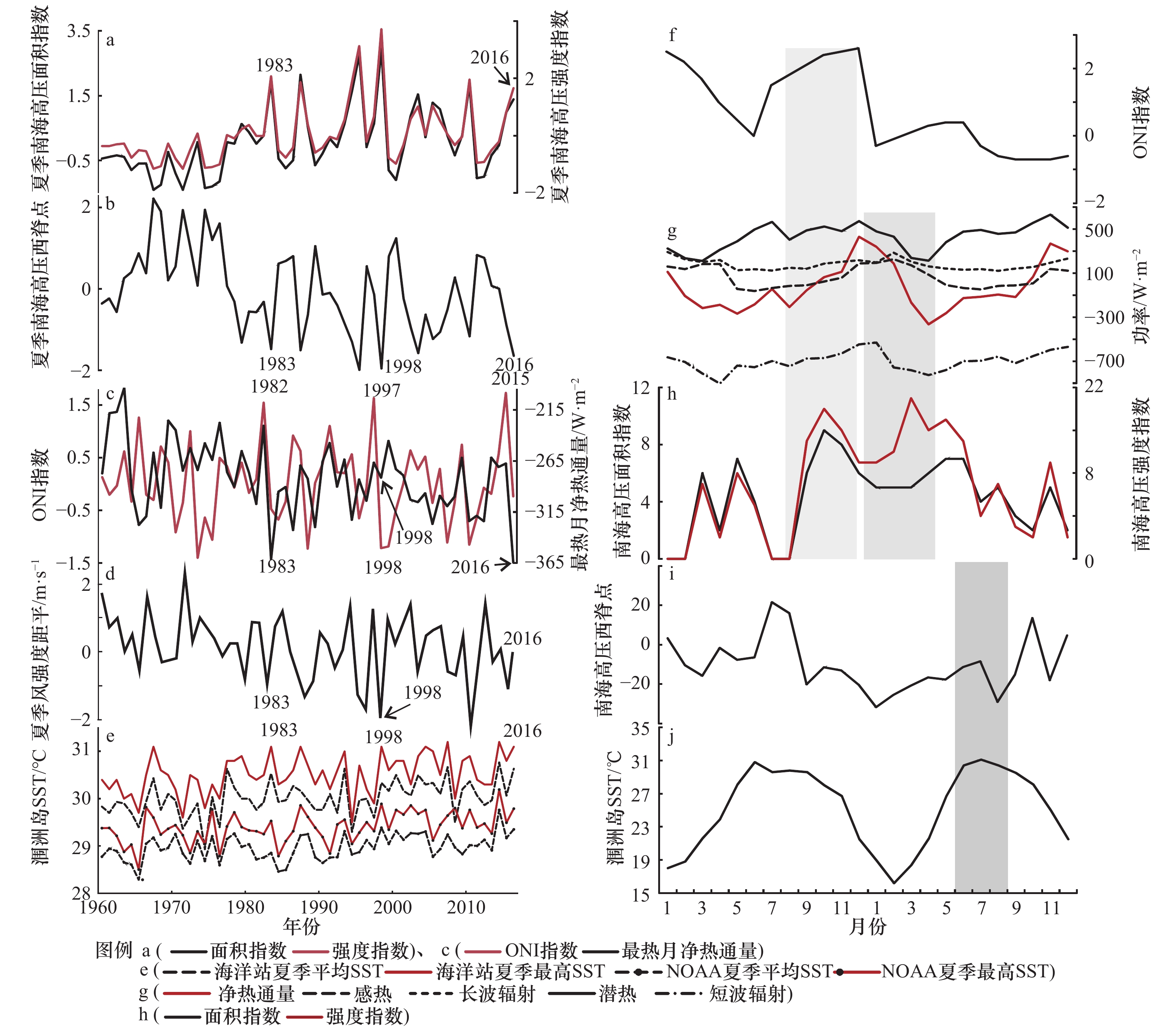Strengthened marine heatwaves over the Beibu Gulf coral reef regions from 1960 to 2017
-
摘要: 在全球气候变化、区域气候因素的共同作用下,海洋热浪频发,北部湾珊瑚礁正处于快速退化之中。探究海洋热浪逐年增强的机制,对预测珊瑚礁未来生长环境具有重要意义。根据北部湾东部4个海洋站(北海、涠洲、海口、东方)实测海表温度历史资料和该海域的相关气候资料,选取SSTA、DHM、DHW、DHD 4种指标,采用相关分析和对比分析法探讨该海域近58年海洋热浪的变化趋势及原因,结果表明:(1)1960−2017年北部湾东部珊瑚礁区海洋热浪爆发的强度及频率逐年波动上升;(2)海洋热浪逐年增强源于全球性的厄尔尼诺事件增多、区域性的高压系统增强及风场减弱等多因素共同作用;(3)全球变暖背景下造成的海洋热浪爆发对北部湾东部海域的珊瑚礁生态系统已经造成不利影响。Abstract: Under the effects of global climate change and regional climate factors, marine heatwaves occur frequently, resulting in a decline of coral reefs over the Beibu Gulf. Understanding the mechanisms of strengthened marine heatwaves is critical for predicting the future evolution of local reef ecosystems. According to sea surface temperature recorded from four marine stations (Beihai, Weizhou, Haikou, Dongfang) in the eastern part of Beibu Gulf, we analyzed the sea surface temperature anomaly (SSTA), degree heating mouths (DHM), degree heating weeks (DHW) and degree heating days (DHD) which are typical proxies for identifying the marine heat waves (MHW) with its tendency and frequency during the past 58 years. The results show that: (1) The intensity and frequency of marine heat waves (MHW) in 1960−2017 displayed an increasing tendency; (2) The strengthened MHW is probably attributed to many factors, including the increase of El Niño events, regional high-pressure system enhancement, wind weakening; (3) MHW caused by global warming will adversely affect coral reef ecosystems over the Beibu Gulf.
-
Key words:
- marine heatwaves /
- SST /
- South China Sea Subtropical High /
- coral reef /
- Beibu Gulf
-
图 2 1960−2017年夏季北部湾海域海洋热浪变化趋势
a. SSTA变化趋势;b. DHM变化趋势;c. DHD变化趋势;d. DHW变化趋势;图中趋势线的b为上升率,R为相关系数
Fig. 2 Tendency of marine heatwaves during the summer of 1960−2017 in the Beibu Gulf
a. SSTA tendency; b. DHM tendency; c. DHD tendency; d. DHW tendency; b is rising rate and R is the correlation coefficient
图 3 1960−2017年夏季南海高压指数:强度、面积指数(a);西脊点(b);ONI指数、北部湾海域最热月净热通量(c);南海夏季风强度距平变化[23](d);涠洲岛海洋站SST、NOAA卫星监测SST(e);2015年1月至2016年12月ONI指数(f);净热通量、感热、潜热、短波辐射、长波辐射(g);南海高压指数:强度、面积指数(h);西脊点(i);涠洲岛海洋站SST(j)
Fig. 3 The trend of summer South China Sea subtropical high indexes in 1960−2017: intensity and area index (a), the west-extending ridge(b); ONI index and net heat flux (c); summer wind speed anomalies in the South China Sea[23] (d); SST of Weizhou Marine Station and NOAA (e); the time series from Janauary, 2015 to December, 2016 of ONI index (f); net heat flux, sensible heat, latent heat, short-wave radiation, long-wave radiation (g); intensity and area index (h); the west-extending ridge (i); SST of Weizhou Marine Station (j)
表 1 量化海洋热浪4种指标的计算方法
Tab. 1 Four proxies for defining marine heatwaves
指标 计算方法 SSTA/℃ SSTA=T-LMST;T为海洋站夏季月平均SST序列,LMST为海洋站的长期平均夏季温度 DHM/℃·月 DHM=Ʃ((T-LMST)>0);T为海洋站夏季月平均SST序列,LMST为海洋站的长期平均夏季温度 DHW/℃·周 DHW=(Ʃ7(T-SSTM))max;T为海洋站夏季日平均SST序列,SSTM为海洋站的最热月平均温度气候值 DHD/d DHD=Ʃ(T-LMST);T为海洋站夏季日平均SST序列,LMST为海洋站的长期平均夏季温度 表 2 3次超强E1 Niño事件参数与热浪指标
Tab. 2 E1 Niño index and MHW indexes of three strong E1 Niño events
持续时间/月 峰值强度/℃ 累计SSTA/℃ 连续超过20℃时间/月 涠洲站 东方站 DHM/℃·月 DHD/d DHW/℃·周 DHM/℃·月 DHD/d DHW/℃·周 1982/1983 15 2.2 20.5 4 0.8 54 10.2 0.2 56 8.2 1997/1998 11 2.4 21.7 5 0.5 54 7.8 0 98 7.2 2015/2016 19 2.6 24.9 6 0.5 37 9.5 1 84 7.3 -
[1] Meehl G A, Tebaldi C. More intense, more frequent, and longer lasting heat waves in the 21st century[J]. Science, 2004, 305(5686): 994−997. doi: 10.1126/science.1098704 [2] Hobday A J, Alexander L V, Perkins S E, et al. A hierarchical approach to defining marine heatwaves[J]. Progress in Oceanography, 2016, 141: 227−238. doi: 10.1016/j.pocean.2015.12.014 [3] Scannell H A, Pershing A J, Alexander M A, et al. Frequency of marine heatwaves in the North Atlantic and North Pacific since 1950[J]. Geophysical Research Letters, 2016, 43(5): 2069−2076. doi: 10.1002/2015GL067308 [4] Garrabou J, Coma R, Bensoussan N, et al. Mass mortality in Northwestern Mediterranean rocky benthic communities: Effects of the 2003 heat wave[J]. Global Change Biology, 2008, 15(5): 1090−1103. [5] Wernberg T, Smale D A, Tuya F, et al. An extreme climatic event alters marine ecosystem structure in a global biodiversity hotspot[J]. Nature Climate Change, 2012, 3(1): 78−82. [6] FröLicher T L, Fischer E M, Gruber N. Marine heatwaves under global warming[J]. Nature, 2018, 560(7718): 360−364. doi: 10.1038/s41586-018-0383-9 [7] Donner S D. An evaluation of the effect of recent temperature variability on the prediction of coral bleaching events[J]. Ecological Applications, 2011, 21(5): 1718−1730. doi: 10.1890/10-0107.1 [8] Smale D A, Wernberg T, Oliver E C J, et al. Marine heatwaves threaten global biodiversity and the provision of ecosystem services[J]. Nature Climate Change, 2019, 9(4): 306−312. doi: 10.1038/s41558-019-0412-1 [9] Hughes T P, Kerry J T, Baird A H, et al. Global warming impairs stock–recruitment dynamics of corals[J]. Nature, 2019, 568(7752): 387−390. doi: 10.1038/s41586-019-1081-y [10] 刘亮, 吴姗姗. 珊瑚礁环境质量变化的价值评估—以涠洲岛为例[J]. 海洋通报, 2015, 34(2): 215−221. doi: 10.11840/j.issn.1001-6392.2015.02.014Liu Liang, Wu Shanshan. Valuation on changes in the quality of coral reef: a study of Weizhou Island[J]. Marine Science Bulletin, 2015, 34(2): 215−221. doi: 10.11840/j.issn.1001-6392.2015.02.014 [11] 赵焕庭, 王丽荣, 宋朝景, 等. 广东徐闻西岸珊瑚礁[M]. 广州: 广东科技出版社, 2009.Zhao Huanting, Wang Lirong, Song Chaojing, et al. Coral Reef in the West of Xuwen, Guangdong Province[M]. Guangzhou: Guangdong Science & Technology Press, 2009. [12] 余克服. 南海珊瑚礁及其对全新世环境变化的记录与响应[J]. 中国科学: 地球科学, 2012, 55(8): 1217−1229. doi: 10.1007/s11430-012-4449-5Yu Kefu. Coral reefs in the South China Sea: Their response to and records on past environmental changes[J]. Science China: Earth Sciences, 2012, 55(8): 1217−1229. doi: 10.1007/s11430-012-4449-5 [13] 陈天然, 余克服. 南海相对高纬度珊瑚对海洋环境变化的响应和高分辨率记录[J]. 第四纪研究, 2014, 34(6): 1288−1295. doi: 10.3969/j.issn.1001-7410.2014.06.18Chen Tianran, Yu Kefu. Responses and high-resolution records for marine environment changes in the relatively high-latitude corals from the South China Sea[J]. Quaternary Sciences, 2014, 34(6): 1288−1295. doi: 10.3969/j.issn.1001-7410.2014.06.18 [14] Kleypas J A, Mcmanus J W, Meñez L A B. Environmental limits to coral reef development: where do we draw the line?[J]. Integrative and Comparative Biology, 1999, 39(1): 146−159. [15] 王文欢, 余克服, 王英辉. 北部湾涠洲岛珊瑚礁的研究历史、现状与特色[J]. 热带地理, 2016, 36(1): 72−79.Wang Wenhuan, Yu Kefu, Wang Yinghui. A review on the research of coral reefs in the Weizhou Island, Beibu Gulf[J]. Tropical Geography, 2016, 36(1): 72−79. [16] Hughes T P, Kerry J T, Baird A H, et al. Global warming transforms coral reef assemblages[J]. Nature, 2018, 556(7702): 492−496. doi: 10.1038/s41586-018-0041-2 [17] Maynard J A, Turner P J, Anthony K R N, et al. ReefTemp: An interactive monitoring system for coral bleaching using high-resolution SST and improved stress predictors[J]. Geophysical Research Letters, 2008, 35(5): L05603. [18] 郑兆勇, 汤超莲, 陈天然, 等. 涠洲岛海洋站1960−2010年DHW变化趋势分析[J]. 热带地理, 2011, 31(6): 549−553. doi: 10.3969/j.issn.1001-5221.2011.06.002Zheng Zhaoyong, Tang Chaolian, Chen Tianran, et al. Variation of DHW during 1960−2010 in Weizhou Island ocean observation station[J]. Tropical Geography, 2011, 31(6): 549−553. doi: 10.3969/j.issn.1001-5221.2011.06.002 [19] 汤超莲, 周雄, 郑兆勇, 等. 未来海平面上升对涠洲岛珊瑚礁的可能影响[J]. 热带地理, 2013, 33(2): 119−123.Tang Chaolian, Zhou Xiong, Zheng Zhaoyong, et al. Possible effects of sea level rise in the future on the coral reef in Weizhou Island[J]. Tropical Geography, 2013, 33(2): 119−123. [20] 余克服, 蒋明星, 程志强, 等. 涠洲岛42年来海面温度变化及其对珊瑚礁的影响[J]. 应用生态学报, 2004, 15(3): 506−510. doi: 10.3321/j.issn:1001-9332.2004.03.030Yu Kefu, Jiang Mingxing, Cheng Zhiqiang, et al. Latest forty two years, sea surface temperature change of Weizhou Island and its influence on coral reef ecosystem[J]. Chinese Journal of Applied Ecology, 2004, 15(3): 506−510. doi: 10.3321/j.issn:1001-9332.2004.03.030 [21] 陈刚, 赵美霞, 刘斌, 等. 基于Reef Check调查的涠洲岛珊瑚礁生态状况评价[J]. 热带地理, 2016, 36(1): 66−71.Chen Gang, Zhao Meixia, Liu Bin, et al. Ecological situation of coral reefs in the Weizhou Island based on reef check[J]. Tropical Geography, 2016, 36(1): 66−71. [22] 刘芸芸, 李维京, 艾秀, 等 月尺度西太平洋副热带高压指数的重建与应用[J]. 应用气象学报, 2012, 23(4): 414−423. doi: 10.3969/j.issn.1001-7313.2012.04.004Liu Yunyun, Li Weijing, Ai Manxiu, et al. Reconstruction and application of the monthly western Pacific subtropical high indices[J]. Journal of Applied Meteorological Science, 2012, 23(4): 414−423. doi: 10.3969/j.issn.1001-7313.2012.04.004 [23] 广东省气象局. 广东省气候变化监测公报(2016年)[R]. 广州: 广东省气象局, 2017.Guangdong Meteorological Service. Climate Change Monitoring Bulletin of Guangdong Province(2016)[R]. Guangzhou: Guangdong Meteorological Service, 2017. [24] Huang Baoyin, Thorne P W, Banzon V F, et al. Extended reconstructed sea surface temperature, version 5(ERSSTv5): upgrades, validations, and intercomparisons[J]. Journal of Climate, 2017, 30(20): 8178−8205. [25] IPCC. Climate Change 2013: The Physical Science Basis[M]. Cambridge: Cambridge University Press, 2013. [26] Selig E R, Casey K S, Bruno J F. New insights into global patterns of ocean temperature anomalies: implications for coral reef health and management[J]. Global Ecology and Biogeography, 2010, 19(3): 397−411. doi: 10.1111/j.1466-8238.2009.00522.x [27] 龚道溢, 何学兆. 西太平洋副热带高压的年代际变化及其气候影响[J]. 地理学报, 2002, 57(2): 185−193. doi: 10.3321/j.issn:0375-5444.2002.02.008Gong Daoyi, He Xuezhao. Interdecadal change in western Pacific subtropical high and climatic effects[J]. Acta Geographica Sinica, 2002, 57(2): 185−193. doi: 10.3321/j.issn:0375-5444.2002.02.008 [28] 孙圣杰. 气候变暖背景下西太平洋副高特征的变异及可能原因[D]. 南京: 南京信息工程大学, 2016.Sun Shengjie. Variation of the West Pacific subtropical high and its possible causes under the background of climate warming[D]. Nanjing: Nanjing University of Information Science & Technology, 2016. [29] Klein S A, Soden B J, Lau N C. Remote sea surface temperature variations during ENSO: evidence for a tropical atmospheric bridge[J]. Journal of Climate, 1999, 12(4): 917−932. doi: 10.1175/1520-0442(1999)012<0917:RSSTVD>2.0.CO;2 [30] Wang Dongxiao, Liu Qinyan, Huang Ruixin, et al. Interannual variability of the South China Sea throughflow inferred from wind data and an ocean data assimilation product[J]. Geophysical Research Letters, 2006, 33(14): L14605. doi: 10.1029/2006GL026316 [31] Liu Qinyan, Huang Ruixin, Wang Dongxiao, et al. Interplay between the Indonesian Throughflow and the South China Sea Throughflow[J]. Chinese Science Bulletin, 2006, 51(S2): 50−58. doi: 10.1007/s11434-006-9050-x [32] 郑崇伟, 周林. 近10年南海波候特征分析及波浪能研究[J]. 太阳能学报, 2012, 33(8): 1349−1356. doi: 10.3969/j.issn.0254-0096.2012.08.016Zheng Chongwei, Zhou Lin. Wave climate and wave energy analysis of the South China Sea in recent 10 years[J]. Acta Energiae Solaris Sinica, 2012, 33(8): 1349−1356. doi: 10.3969/j.issn.0254-0096.2012.08.016 [33] 黄卓, 徐海明, 杜岩, 等. 厄尔尼诺期间和后期南海海面温度的两次显著增暖过程[J]. 热带海洋学报, 2009, 28(5): 49−55. doi: 10.3969/j.issn.1009-5470.2009.05.008Huang Zhuo, Xu Haiming, Du Yan, et al. Two sea-surface warming events in the South China Sea during and after El Niño[J]. Journal of Tropical Oceanography, 2009, 28(5): 49−55. doi: 10.3969/j.issn.1009-5470.2009.05.008 [34] 马斌儒. 广西涠洲岛珊瑚礁现状及其保护策略研究[D]. 广州: 中国科学院南海海洋研究所, 2007: 32−38.Ma Binru. Status and conservation strategies of the coral reef in Weizhou Island, Guangxi[D]. Guangzhou: South China Sea Institute of Oceanology, Chinese Academy of Sciences, 2007: 32−38. [35] 王国忠, 全松青, 吕炳全. 南海涠洲岛区现代沉积环境和沉积作用演化[J]. 海洋地质与第四纪地质, 1991, 11(1): 69−82.Wang Guozhong, Quan Songqing, Lü Bingquan. Evolution of modern sedimentary environments and sedimentations in the Weizhou Island Area, South China Sea[J]. Marine Geology & Quaternary Geology, 1991, 11(1): 69−82. [36] 赵焕庭, 王丽荣, 宋朝景, 等. 雷州半岛灯楼角珊瑚岸礁的特征[J]. 海洋地质与第四纪地质, 2002, 22(2): 35−40.Zhao Huanting, Wang Lirong, Song Chaojing, et al. Features of fringing reef at Dengloujiao, Leizhou Peninsula[J]. Marine Geology & Quaternary Geology, 2002, 22(2): 35−40. [37] 梁文, 黎广钊, 范航清, 等. 广西涠洲岛造礁石珊瑚属种组成及其分布特征[J]. 广西科学, 2010, 17(1): 93−96. doi: 10.3969/j.issn.1005-9164.2010.01.025Liang Wen, Li Guangzhao, Fan Hanqing, et al. Species composition and distribution of coral on Weizhou Island, Guangxi[J]. Guangxi Sciences, 2010, 17(1): 93−96. doi: 10.3969/j.issn.1005-9164.2010.01.025 [38] Yu Kefu, Zhao Jianxin, Shi Qi, et al. U-series dating of dead Porites corals in the South China Sea: Evidence for episodic coral mortality over the past two centuries[J]. Quaternary Geochronology, 2006, 1(2): 129−141. doi: 10.1016/j.quageo.2006.06.005 [39] Wilkinson C. Status of Coral Reefs of the World: 2008[M]. Townsville: Global Coral Reef Monitoring Network and Reef and Rainforest Research Centre, 2008. [40] Frieler K, Meinshausen M, Golly A, et al. Limiting global warming to 2℃ is unlikely to save most coral reefs[J]. Nature Climate Change, 2013, 3(2): 165−170. doi: 10.1038/nclimate1674 -





 下载:
下载:


